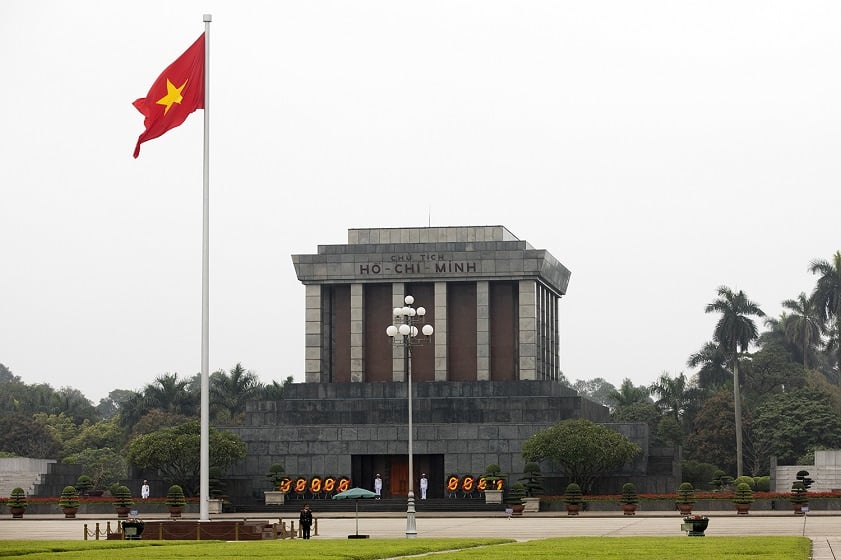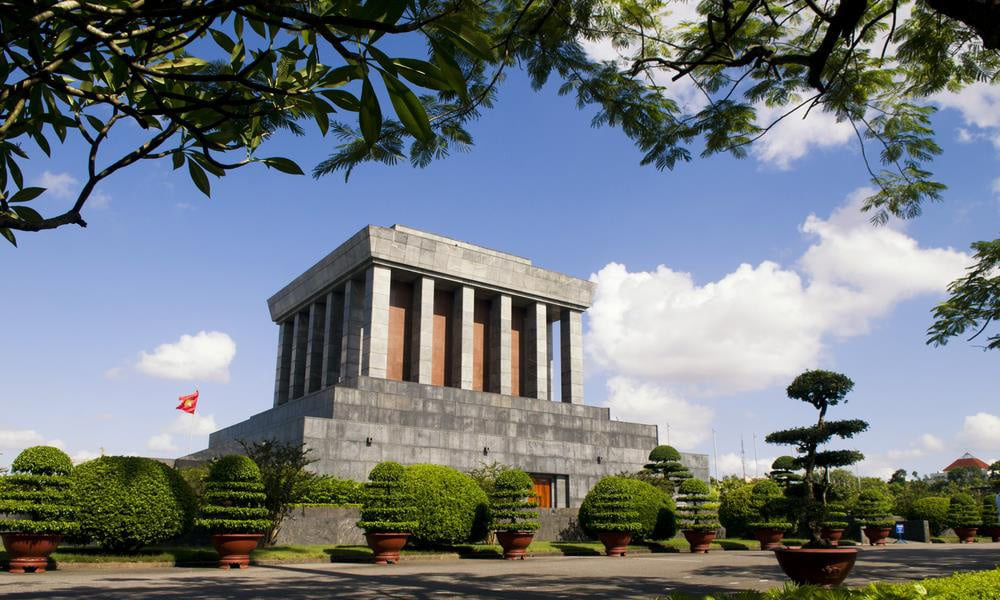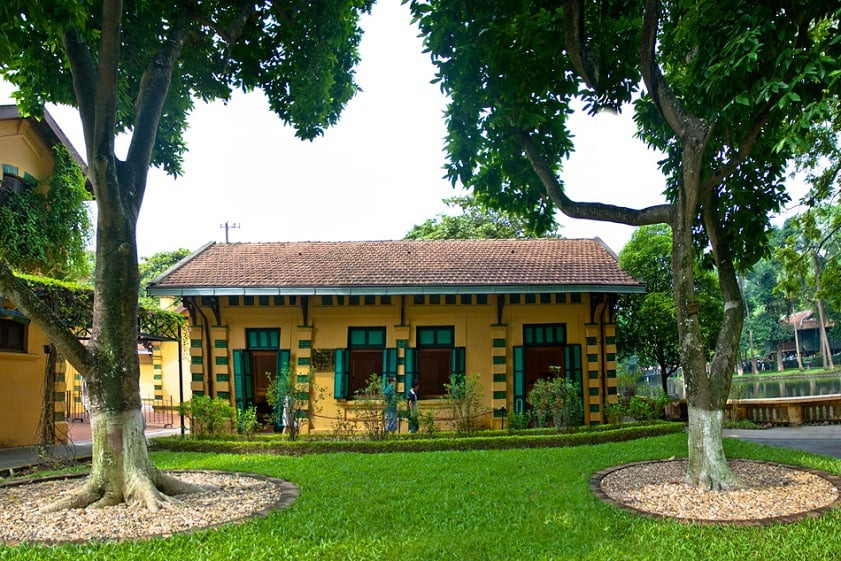Ho Chi Minh Mausoleum is one of the most famous works in Vietnam. Thanks to its great cultural and historical value, it attracts a large number of domestic and international tourists each year. Coming to Ho Chi Minh Mausoleum, you can learn more about Ho Chi Minh’s life and his significance in Vietnamese history, as well as expand your understanding of the country through many nearby relics. This article will be the best guide for your first-ever trip to Ho Chi Minh Tomb. Read it to the end!
1 Who is Ho Chi Minh?
Ho Chi Minh is widely regarded as a visionary leader who played a pivotal role in shaping the course of Vietnam’s history. With his indomitable spirit and unwavering determination, Ho Chi Minh emerged as a revered figure, leading the Vietnamese people towards independence and self-determination. He spearheaded the revolutionary movement against foreign colonial powers, particularly the French and later the Americans, and ultimately paved the way for Vietnam’s liberation. Ho Chi Minh’s significant contributions and tireless efforts earned him the status of a revered statesman, inspiring generations with his devotion to the nation’s welfare and his unwavering commitment to social justice and equality.
Visiting Ho Chi Minh Mausoleum is widely regarded by the Vietnamese as a prestigious honor, justifying the arduous journey undertaken by many citizens.
2. Where is Ho Chi Minh Mausoleum? How to get there?
Ho Chi Minh Mausoleum is located in the middle of Ba Dinh Square, where President Ho Chi Minh used to preside over rallies. The exact address is 2 Hung Vuong, Dien Bien Ward, Ba Dinh District. To get here, you can go by private vehicle or public bus.
If you ride motorbikes or drive cars on your own, remember to note the two parking spots on Ong Ich Khiem Street (opposite the Mausoleum Guard Command) and Ngoc Ha Street (the entrance to Ho Chi Minh Museum). If you take the bus, you can refer to some routes that pass by Ba Dinh Square, namely the buses number 09, 33, 22, 45, and 50.

Ho Chi Minh Mausoleum is located in Ba Dinh Square, Hanoi
3. The history and significance of the mausoleum of Ho Chi Minh
In his will, President Ho Chi Minh wanted to be cremated and had his ashes laid in the three regions of the country after his death, but according to the will of the Party and people at that time, the government decided to keep his body intact and placed it in the Mausoleum so that people can come to commemorate and visit him.
In January 1970, the Government of the Soviet Union and Vietnam met to discuss the design and construction techniques of the Mausoleum. Then, the task of designing the Mausoleum was approved by the Politburo of the Central Committee of the Party, with major support from Soviet experts.
On September 2nd, 1973, the groundbreaking ceremony of the mausoleum officially took place. On May 19th, 1975, Ho Chi Minh Mausoleum was inaugurated. The Lenin’s Tomb in Moscow served as an inspiration for Ho Chi Minh Mausoleum’s design, which was altered to better suit Vietnamese customs and styles.
Ho Chi Minh Mausoleum is a work of great significance, showing the deep feelings that Vietnamese people have for their leader. Today, Ho Chi Minh Tomb is not only a cultural and historical symbol of Hanoi but also attracts a large number of tourists to visit. Since its inauguration in 1975, many generations of Vietnamese people and millions of foreign visitors have come to this place.

The Mausoleum of Ho Chi Minh’s official groundbreaking ceremony was held on September 2nd, 1973
4. Ho Chi Minh Mausoleum opening hours
The Mausoleum is open in the morning of every Tuesday, Wednesday, Thursday, Saturday, and Sunday. The precise opening hours are as follows:
- Summer & Fall (April – October): 7:30 a.m – 10:30 a.m
- Winter & Spring (November – March): 8:00 a.m – 11:00 a.m
*** Opening hours are extended by 30 minutes on weekends and public holidays.
Ho Chi Minh Mausoleum is closed to visitors in the afternoon or on Mondays and Fridays. The Mausoleum will remain accessible to tourists if May 19th, September 2nd, or the first day of the Lunar New Year falls on a Monday or a Friday. In order to perform maintenance, it frequently closes for two months in the fall (October and November).

Ho Chi Minh Mausoleum opening hours change depending on the season of the year
5. The top 3 things to do on your trip to Ho Chi Minh Mausoleum
5.1. Explore the architectural structure of the mausoleum
- Outside Ho Chi Minh Mausoleum
In front of the Mausoleum is Ba Dinh Square with a road for parades and 79 green French marigold trees, which represent President Ho Chi Minh’s age of 79. Ho Chi Minh Mausoleum’s overall design is a solid square block measuring 21.6 meters in height and 41.2 meters in width. The Mausoleum’s exterior is made of gray granite. Two soldiers are always on duty in front of the Mausoleum, whose shifts change every hour.

Ba Dinh Square in front of Ho Chi Minh Mausoleum
- Inside Ho Chi Minh Mausoleum
A room covered in marble can be found inside Ho Chi Minh Mausoleum. Here, the body of President Ho Chi Minh is placed in a glass casket. The copper bed has a lotus-like pattern on it. Toughened glass made up three of the bed’s sides. Visitors can see President Ho Chi Minh through the clear glass, dressed in a faded khaki shirt and simple rubber sandals on his foot. Four soldiers are always on guard inside the room.
5.2. Watch the flag-raising and lowering ceremonies
If possible, plan your trip so that you can attend the daily flag-raising and lowering ceremonies at 6 a.m. and 9 p.m. respectively in Ba Dinh Square. These ceremonies will undoubtedly enhance your trip’s meaning and deepen your love for this nation.

The flag-raising ceremony at Ho Chi Minh Mausoleum
5.3. Visit other historic attractions in the complex
Visitors who come to Ho Chi Minh Mausoleum Complex can learn a great deal about Uncle Ho’s life and the Vietnamese liberation movement under his leadership.
- Ho Chi Minh Museum
Ho Chi Minh Museum is the first location you should consider coming to after visiting Ho Chi Minh Mausoleum. This one-of-a-kind museum was constructed inside the Ho Chi Minh Complex, which took almost 5 years to complete.
Meetings, conferences, and scientific seminars for Vietnam’s national and international organizations are held in the 400-seat hall on the first floor of the museum. On the second floor, the museum’s expansive collection of more than 2,000 priceless historical artifacts and exhibits depict Uncle Ho’s life and the various stages of Vietnam’s revolution.

Ho Chi Minh Museum was built to honor Ho Chi Minh’s 100th birthday
- Presidential Palace
The Presidential Palace has distinctive architecture with a yellow color. This was intended to be Ho Chi Minh’s residence and working place. However, Uncle Ho declined and stated that it would be improper for him to live in such a lavish big building while his people were still in need and hungry. He lived in a small house in the rear instead (House No. 54).

The Presidential Palace used to be Hanoi’s most opulent building because of its unique architecture
- House No. 54
This house is where President Ho Chi Minh worked from December 1954, so it was named “House No. 54”. Three rooms make up this tiny house. One is the working room of Uncle Ho, another is the kitchen, and his bedroom is the last one. The kitchen had a thermometer, and Ho Chi Minh would ask for a day off for elementary students whenever the temperature dropped below 10 degrees Celsius.

All the utensils in House No. 54 are gifts from people from all over the country
- Ho Chi Minh’s house on stilts
After spending four years in House No. 54, President Ho Chi Minh moved to this stilt house. A fish pond and a variety of orchids that bloom all year round can be found in front of the house. The fish even used to rise to the surface when they heard sound, as the President used to clap his hands each time he fed the fish. Their habit remained even after Uncle Ho’s passing.

Ho Chi Minh’s house on stilts is a simple house located in the heart of Hanoi city
- One Pillar Pagoda
One Pillar Pagoda was recognized as “the pagoda with the most unique architecture in Asia”. The pagoda was built in 1049, during the reign of King Ly Thai Tong. In the center of a pond stands a wooden square pagoda supported by a solitary concrete pillar. It was designed to resemble a lotus flower.

One Pillar Pagoda’s distinctive design resembles a lotus rising from the pond
6. Note Ho Chi Minh Mausoleum rules for the best visit
There are some must-know rules when visiting Ho Chi Minh Mausoleum in Hanoi:
DO:
- Dress neatly and formally
- Keep quiet inside the Mausoleum
- Have your belongings inspected at the security counter
- Follow the officers’ instructions when standing in line
- Lower your hat and keep it in your right hand.
DO NOT:
- Film, take pictures, or make drawings
- Bring any food or electrical items into the Mausoleum
Ho Chi Minh Mausoleum is one of the most well-known tourist destinations in Vietnam. Do not pass up the opportunity to visit the final resting place of Vietnam’s greatest leader and take in the serene and solemn atmosphere here. Hopefully, you and your loved ones will have a wonderful trip! To travel without problems, remember to take note of the opening hours and rules of the Mausoleum!

